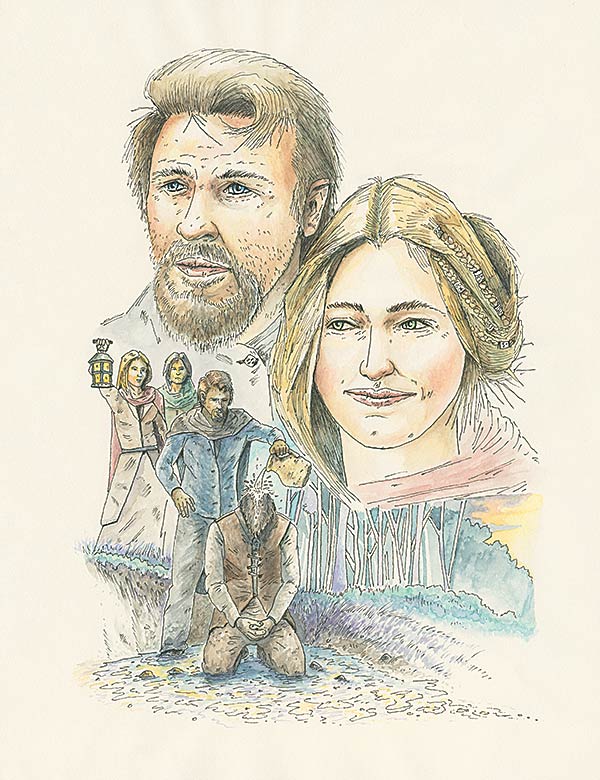Subtotal: $
Checkout-

The Blessed Woman of Nazareth
-

New Heaven, New War
-

Born to Us
-

My Fearless Future
-

Covering the Cover: School for Life
-

The Community of Education
-

Readers Respond: Issue 19
-

Family and Friends: Issue 19
-

Verena Arnold
-

Tundra Swans
-

A Debt to Education
-

What’s the Good of a School?
-

A School of One
-

On Praying for Your Children
-

The World Is Your Classroom
-

The Good Reader
-

Orchestras of Change
-

The Habit of Lack Is Hell to Break
-

Soviet Kindergarten
-

The Given Note
-

Editors’ Picks Issue 19
-

Litanies of Reclamation
-

The Children of Pyongyang
-

How Far Does Forgiveness Reach?
-

A Trio of Lenten Readers

Next Article:
Explore Other Articles:
In March of 1525, a young couple new to Zurich found themselves in what would prove to be a dangerous Bible study. The group of Christians had started meeting only two months before to discuss the ideas of the Reformation. They sought to return to the simplicity of the early church, and became convinced that baptism was something that only adult believers should undertake. And so, that spring, Michael Sattler was baptized as an adult – a crime under both civil and church law, punishable with death. He and his wife, Margaretha, were now part of the new movement of “re-baptizers,” or Anabaptists.
Born in southern Germany around 1490, Michael had entered a Benedictine monastery near Freiburg, where he had served as prior; Margaretha had been a Beguine. They had both encountered the ideas of the Reformers, and each found in the other a partner eager to follow Christ with their whole lives.
In Zurich, Michael quickly became a leader in the Anabaptist group. When it was disbanded, the couple was expelled from the city. Seeking to preserve this community of revival, Michael met with Martin Bucer and other mainstream Reformation leaders. But the Sattlers’ uncompromising stance went too far for the more cautious reformers.
I will with thy help on this day testify to the truth and seal it with my blood.
More and more people sought to enter illegal Anabaptist communities. But they were scattered and hidden. Finally, in February 1527, Michael presided over a gathering of radical leaders. Here, they drafted what would come to be called the Schleitheim Confession, after the Swiss town where they met. It outlined the fundamental principles of their movement, based on the Sermon on the Mount. These included voluntary baptism for believers only, with no compulsion in religion; nonviolence; and mutual accountability in the church.
When the Sattlers returned home from this meeting, they were almost immediately captured by Austrian forces. In addition to the charge of Anabaptism, Sattler was accused of being a traitor for opposing war against the Ottoman Turks:
If the Turks should come, we ought not to resist them. For it is written [Matt. 5:21]: Thou shalt not kill. We must [rather] beseech God with earnest prayer to repel and resist them.… If warring were right, I would rather take the field against so-called Christians who persecute, capture, and kill pious Christians than against the Turks [who] know nothing of the Christian faith.
As the trial began, the Archduke deployed soldiers for fear of an uprising.
Five days later, on May 20, 1527, Michael Sattler was tortured and burned alive. On his way to the execution site he called on the crowds to repent, and prayed for the judges. Eight days after her husband’s death, Margaretha was drowned in the River Neckar. She said she would have rather gone to the fire with her husband.
“Almighty, eternal God,” Sattler prayed as he was bound to the stake, “Thou art the way and the truth; because I have not been shown to be in error, I will with thy help on this day testify to the truth and seal it with my blood.”

Jason Landsel, Michael and Margaretha Sattler
For more about Michael and Margaretha Sattler, see Bearing Witness.
Already a subscriber? Sign in
Try 3 months of unlimited access. Start your FREE TRIAL today. Cancel anytime.




































Ron Unruh
Hello Jason, I have read your article about Michael Stattler and his wife Margaretha, touched me deeply, specially with your graphic, that personalized it more profoundly, since I have now spent months reviewing sources and writing a family history that seeks to tell all my succeeding generations the story of how our Dutch/Belgic/German ancestors came into a world dominated by a Catholic Church that had created so many aberrations to the simple gospel that a reformations was required. My people in those earliest years became followers of the Anabaptist beliefs, were committed to the Menno Simons strain, and moved to Poland/Prussia and then to S.Russia (Ukraine) and to CAN. The cruelty of humans upon humans, of non-Christians against Christians and then Christians against Christians has broken my heart so many times. I am 80, spend 50 yrs as preacher and denominational leader ... seen people come to Christ and rejoice in all of that, and yet grieve over the darkness that controls the lives of individuals and the governments of countries. Thanks for your work. I too am an artist, first hobbyist, and in retirement doing much commission work, landscapes and portraits.